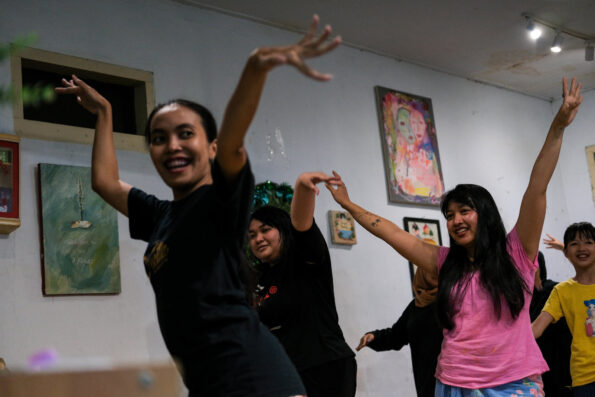
Yam Kumari Kandel, GPJ Nepal
Professional male and female shamans perform a cultural incantation and dance during a political rally in September 2017, in Dhulikel, the administrative capital of Nepal's Kavrepalanchowk District. Shamanism is typically a cultural, religious and professional practice among Nepalese men, but women are now taking up the role.
KATHMANDU, NEPAL — A sign welcoming visitors to a private place of worship hangs outside an old, two-story house in the Kathmandu Valley, west of Nepal’s capital. Inside, Hindu devotees pray to deities, some of whom are illustrated in large, colorful paintings and posters on the walls.
Sabita Basnet is here hoping to find a cure to an illness she says doctors have been unable to diagnose. Three months earlier, her heart and throat began to ache. Her skin became irritated and she began having bad dreams.
These are signs that she is possessed by an evil spirit, says Manisha Tamang, a shaman. With the help of five other shamans — three women and two men — Tamang attempts to cast out the spirit. Tamang waves an oil lamp, a piece of red cloth and then a plate made of leaves containing rice over Basnet’s head, as her fellow shamans beat large frame drums and chant loudly, while circling Basnet, who is seated on a floor mat.



Over the past six years, the 23-year-old Tamang says she has treated and prayed for several people who have had health issues similar to Basnet’s. Being a shaman is Tamang’s full-time job, though the job is traditionally more common among men in Nepal.
“The goddess has granted me the power to serve the people. I am very happy for it,” Tamang says, referring to Kali, the Hindu goddess of time, doomsday and death.
Women are increasingly assuming what is locally considered a prestigious religious role and job. Local experts say the growing trend of female shamans is a result of emigration among Nepal’s men, many of whom are leaving the country in search of other jobs.
“In the current scenario where most of the men have gone abroad, the role of shaman has transferred to women,” says Janak Rai, an associate professor of anthropology at Tribhuvan University.
Advocates say women become shamans to be of service to their local communities and to make a living.
In Hinduism and Buddhism, two of the main religions practiced in Nepal, shamans are believed to cure diseases and help people resolve other difficult situations with their spiritual guidance. Shamans help those in search of solutions by entering into a trance, during which they say they consult deities and spirits and are able to see one’s past and future.



For years, shamanism was a rare practice among Nepalese women because society believed women with the ability to heal others and perform other supernatural works were witches, Rai says.
Recently, people are welcoming the practice among women, Chet Bahadur Singh says. Singh is a shaman and member of the Nepal Shamans’ Association, based in Kathmandu and founded in 2015. The group has 90 members, all shamans, from across the country. Half of the members are female, ranging from ages 9 to 50. Singh says all 45 female members practice shamanism professionally and are compensated by clients for their services.
Traditionally, shamans accept donations from clients or do not request compensation at all. Rai says accepting payments from clients who are ill goes against long-standing tradition and values in shamanism.
“In villages and communities, shamans are serving their sick neighborsattacked by evil souls by chasing away such evil spirits. They do it free of cost,” he says. “It’s not good to provide the service by charging fees like shamans do in Kathmandu.”
Tamang, who became a shaman after consulting Singh, her mentor, says she helps about five clients each week and earns between 10,000 to 15,000 Nepalese rupees ($95 to $145) each month. But Tamang says she does not charge her clients. All of her earnings are donations, or what she says her clients describe as tokens of appreciation.
One day she may get 5,000 rupees ($50) from patients. Another day, it is 100 rupees (97 cents), she says. “So, it depends on generosity of the patients.”
Sagar Ghimire, GPJ, translated this article from Nepali.










